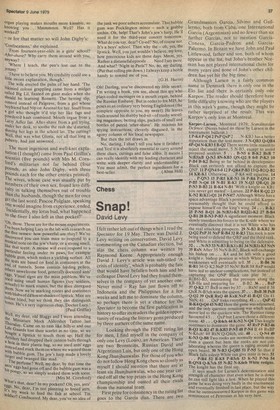Chess
Snap!
David Levy
I felt rather left out of things when I read the Spectator for 19 May. There was David J. Levy writing on conservatism, David Levy commenting on the Canadian election, but alas the chess column was written by Raymond Keene. Appropriately enough David J. Levy's article was sub-titled 'A crisis of identity', which is probably the fate that would have befallen both him and his colleague David Levy had they found themselves in the company of yet another one. Never mind — Ray has just flown off to Indonesia and the Philippines for a few weeks and left me to dominate the column, so perhaps there is yet a chance for the Spectator to become the first publication in history to offer its readers the golden opportunity of reading the literary gems produced by three authers of the same name.
Looking through the FIDE rating list for men, I find myself in the company of only one Levy (Louis), an American. There are two Bronsteins, Russian David and Argentinian Luis, but only one of the Hong Kong Jhunjhunwalas. For those of you whodo not follow Hong Kong chess so closely as myself I should mention that there are at least six Jhunjhunwalas, who one year carried off all the top prizes in the Hong Kong championship and ousted all their rivals from the national team. First prize for consistency in the rating list goes to the Garcia clan. There are two Grandmasters Garcia, Silvino and Guillermo, both from Cuba, one International Garcia (Argentinian) and no fewer than six further Garcias, not to mention GarciaConesa, Garcia-Padron and GarciaPalermo. In Britain we have John and Paul Littlewood, father and son, both of whom appear in the list, but John's brother Norman has not played international chess for many years and none of John's other children has yet hit the big time.
Although Larsen is a fairly common name in Denmark there is only one in the Elo list and there is certainly only one Karpov. The reader should therefore have little difficulty knowing who are the players in this week's game, though they might be rather surprised at the result. This was Karpov's only loss at Montreal.
Karpov-Larsen, Montreal 1979: Scandinavian Defence. (Notes based on those by Larsen in the tournament bulletin.) 1 P-K4 P-Q4 2 PxP QxP 2. .. N-KB3 has a better reputation than the text move. 3 N-QB3 Q-QR4 4P-Q4 N-KB3 5 B-Q2 There seems little reason to reject the usual move, 5 N-B3, except to avoid prepared analysis. 5 . . . B-N5 6 B-K2 BxB 7 N(B3)x8 Q-N3 8N-KB3 QN-Q2 9 0-0 P-K3 10 P-B4 B-K2 Being so far behind in development Black can certainly not afford to capture the QNP. 11 P-QN4 0-0 12 P-QR4 P-B3 13 Q-B2 Q-B2 14 KR-K1 Otherwise ... P-K4 will equalise. 14 . . . P-QN3 15 P-R5 KR-N1 16 P-R6 P-QN4 17 P-B5 N-Q4 18 N-B1 R-K1 19 N-Q3 QR-Q1 20 P-N3 B-B3 21 R-K4 N-Bl 'With a knight on KB1 you never get mated' — Larsen. 22 P-R4 R-Q2 23 K-N2 R(K1)-Q1 24 P-N4!? Although White has a space advantage Black's position is solid. Karpov presumably thought that he could afford to expose himself on the king's wing. 24 . . . R-K1 25 P-N5 B-Q1 26 N(B3)-K5 R(Q2)-K2 27 B-B4 Q-B1 28 B-N3 P-B3 A significant moment. Black slowly transfers his forces to the K-side where we eventually discover that it is not White who has the real attacking prospects. 29 N-B3 R-KB2 30 Q-Q2 PxP 31 NxP R-B4 32 R-R3 This rook is now being used to defend the QRP and the third rank, and White is admitting to being on the defensive. 32. . . N-N3 33 N-B3 R(K1)-B134 N(B3)-K5 NxN 35 RxN After 35 NxN B-B2, Black will exchange his bishop on .. . K4 and be left with a good knight v. bishop position in which White's pawn weaknesses will eventually tell. 35 . . . R-B6 36 R-R 1 36 Q-K2 NxP 37 NxN! RxR 38 RxP would have led to unclear complications, but instead of capturing the QNP Black can play 36 ... R(136)-B3, maintaining the pressure along the KB-file and preparing for. . . B-B2. 36. . . BxP 37 Q-K2 37 BxB is met by 37. . . RxN! and if 38 QxR N-B5ch wins the queen. 37. . . BxB 38 PxB Q-Q2 39 QxR RxQ 40 KxR NxP 41 R-Q1 On 41 NxN, 41 .. . QxP forks everything. 41 . . . QxP 42 R-K4 Q-Q4 43 N-B2 Here the same was adjourned, and the only question remaining was which sealed move led to the quickest win. The Russian camp favoured 43. . . QxP but Larsen chose a different route. 43 . . . Q-R4ch 44 K-N2 N-Q4 This knight continues to dominate the game. 45 RxP P-R3 46 R-Q3 K-R2 47 R-KB3 P-N5 48 P-N4 If 48 RxBP N-K6ch! 49 RxN Q-Q4ch, etc. 48. . . Q-N4 49 K-N3 Q-B8 Two rooks are normally worth more than a queen but here the rooks are not collaborating whereas the queen is raging around an open board. 50 N-R3 Q-QB5 51 P-N5 So that if Black falls asleep White can give mate in two. 51 • . . P-R4 52 R-K8 P-R5ch 53 K-N2 P-N6 54 R-QN8 Q-K7ch 55 N-B2 N-K6ch White resigns. The knight has the final say. It says much for Larsen 's determination and strength of character that even when he is down he can still fight like a lion. When he played this game he was doing very badly in the tournament and eventually finished in last place, but the way that he outmanoeuvred Karpov in this game was reminiscent of Petrosian at his very best.










































 Previous page
Previous page